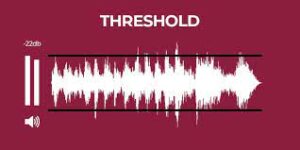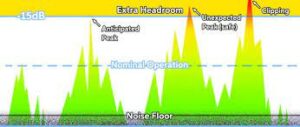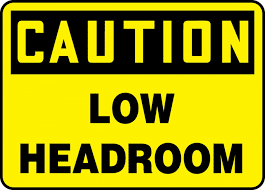 The input-related dynamic range of modern hearing aids (also known as its input “Headroom”) is important to know in order to prevent distortion and input-clipping of louder sounds in the environment.
The input-related dynamic range of modern hearing aids (also known as its input “Headroom”) is important to know in order to prevent distortion and input-clipping of louder sounds in the environment.
Typical loud input sounds are music and the level of a hearing aid consumer’s own voice.
Up until recently, the highest-level sound that could be successfully transduced into a hearing aid through its analog-to-digital converter (ADC) was on the order of the mid-90 dB SPL range. Hearing aid users’ own voices at the level of their own hearing aid could easily overdrive the “front end” of their hearing aids resulting in a generation of hard of hearing people who were not able to hear their own voices well. And amplified music was usually distorted so much at the front end of the hearing aid that no amount of software programming manipulation could improve things.
However, in this last generation of hearing aids we are now at the point where signals up to 109 dB SPL can successfully be transduced through the ADC with minimal distortion.
Hearing aids can be designed that are capable of transducing even higher levels but in many cases there would be a significant current consumption issue that would limit its usage. Therefore other technologies, in conjunction with modern technology need to be used to at least bring the input dynamic range up to the level of modern hearing aid microphones (up to 119 dB SPL).
Hearing aids still should have output limiting of some sort to prevent the amplified sound from exceeding the individual’s tolerance level, but this “109 dB SPL” number refers to the input, even before any processing occurs.
While 109 dB SPL does sound much better than a maximum level of 95-100 dB SPL, we still have a way to go since many of the peaks of music far exceed 109 dB SPL. Modern hearing aids that boast a maximum input level of 109 dB SPL imply that only the newer ADC technology is used, but nothing else.
So, what else?
Some manufacturers use an analog compressor that runs off of the microphone pre-amp circuitry that reduces the input prior to the ADC (and then digitally re-expands the signal to its original shape and magnitude once digitized). This is analogous to “ducking under a low hanging bridge and then standing up again”. Manufacturers that use this technique can specify maximum input levels on the order of 112-115 dB SPL before distortion occurs- this is a significant improvement and many manufacturers consider this approach to be “good hearing aid design engineering”.
Another approach that can be used in conjunction with modern hearing aid technology is “auto ranging” of the ADC circuitry. This 30 year old technology is still used widely in the hearing aid industry and is based on the definition of “dynamic range”. The dynamic range is the difference between the lowest level sound and the highest level sound that can be transduced without distortion. A 100 dB dynamic range can be 0 dB SPL to 100 dB SPL, or equivalently, 20 dB SPL to 120 dB SPL, where the later range is arguably better for speech. Technologies exist to allow the front end ADC to “auto range” to fit the nature of the input thereby preventing distortion from louder sounds such as music.
And yet a third approach would be to use the current technology that can provide inputs of up to 109 dB SPL without distortion, but increase it to 112 dB SPL or greater but sacrifice some of the battery life due to voltage-related issues. With the advent of ubiquitous rechargeable technology, this “voltage related/improved front end” trade-off may be acceptable for many hearing aid users.
If a hearing aid manufacturer advertises a 109 dB SPL “headroom” you can be assured that this is “only” the current technology, but if that number is greater than 109 dB SPL, then you can be assured that one or more other “tricks” such as analog compression before the ADC or auto-ranging have been used in conjunction with current technology.









> hearing aid manufacturer advertises a 109 dB SPL
Do they actually publish any technical specs that a consumer can get their hands on? Those of us in tech are used to wading through specifications and data sheets, but once we need hearing aids all we seem to get are fitting charts. One day soon I hope we can get decent specs and, horror, compare them.
Hearing aid manufacturers, if anything, publish only the specifications that are outlined in the ANSI S 3.22 document which tells audiologists how to test a hearing aid. This is a “reporting” standard so that an audiologist on Tuesday March 8 in Toronto will be doing the exact same test as another audiologist in Montana on Thursday Dec 3. In other words, this “specification” merely states what a hearing aid can do in a very narrow range of technical tests… it is only a “quality control” test. There are no tests or standards anywhere in the world that are “performance” standards that say that a hearing aid should function in a certain way.
If a hearing aid is made of chocolate and distorts at 100%, this is acceptable as long as the ANSI S 3.2 specification says that it distorts at 100%, and it can be made of chocolate or anything else.
The peak input limiting level that states the highest level sound that can be transduced (and digitized) by a hearing aid is not something that has ever been a part of ANSI S 3.2, and it is therefore up to the individual manufacturer to publish that data.
The only reason why some manufacturers do publish that number is because people like me ask for it…. but when asked, an audiologist can ask the manufacturer and that number should now be at the ready for anyone of the other end of the telephone.
It is not acceptable for impacting cochlear levels to be arbitrarily increased or decreased without knowledge of tolerances of cochlear performances. It appears that ignorance of such tolerances causes imaginary corrections in amplification technology. Hearing loss due to impacting acoustical pressures begin at about 60 dbA. It is a combination of pressure and time exposure on the ribbon synapses that work in conjunction with vesicle production at the synapses that are activated and the efficacy of the GABA neurotransmitter to “compromise” and create stable tolerances.
This reckless amplification measures is instigated by the manufacturers who cannot see the further effects of hidden damage that begins at the spiral ganglion synapses. The idea is clear: amplification values at the IHC’s should be calculated to ensure that the synaptic coding calculated to vary the vesicle values are not increasing the amplification values and damage the spiral ganglion fibers. WE need to calculate the reverse values and I know that the first step should be to reduce the MPO’s and not increase them! Hidden hearing loss should be detected and sound values controlled down and not ignorantly be increased to fulfil a public demand. ! WE need to address this issue from a completely different scientific and biologic perspective. Marshall, what is your take on this?
The issue in an input-related one and has nothing to do with gain or output. It is still crucial to limit the output for a number of reasons. The 109 dB SPL merely refers to the level of the input that is not distorted, and depending on the hearing loss, the output can be much lower. That is, the hearing aid can provide negative gain.
I am glad Marshall is opening the world to a better understanding of loudness and input relationships! The cochlea is quite fragile in its resistance to louder sounds, and because the damage to the ribbon synapses takes a while we tend to think that not much is happening inside the cochlea. Sensory loss i almost always preceded by hidden hearing loss, and vesicle chaos! To understand the degradation, a tribe near Mount Kilimanjaro was examined for hearing loss in the 60’s. This tribe lives at altitude, and suffered no effects of noise damage. Their average reported thresholds were around PTA’s of 10db, but HF PTA’s were not know then. The testing involved ages up to 100 !The findings were revealed in ENT research. I believe that if we lower the MPO of hearing aids to about zero, we will be able to stop sensory damage to the cochlea and the SG cells. In 2018, Phonak was sending new HA orders in the muted configuration to offices for new fittings. The sound with the aids muted was so good, that I tried them in new patients with great results! Opening up the aids caused a huge influx of noise that could not be dampened, and pretty much stayed that way. I don’t know if Phonak still uses the muted configuration ? I have tried these aids in environmental traffic conditions at about 79dbA and the results were spectacular!
I am not sure what the “muted” condition was on the Phonak hearing aids, so I cannot provide an opinion on that.
To date, much to the frustration of researchers, they have not been able to find much evidence of “hidden hearing loss” in humans. This may turn out to be a non-human mammal phenomenon (?)
I play mandolin and am having major difficulty hearing when the entire band is playing. (I’m 83) At times it appears that I am playing out of tune. I recently noted that when I tune my E string (659.2 hz) I have loud feedback sound in my right hearing aid only. Can this frequency be notched in the right device only?
I have ReSound One hearing aids.
Thank you…
Hi Paul- I am not sure of the peak input limiting level of the Resound One hearing aids, but I doubt whether its the fundamental at 659 Hz that is the culprit- it is probably the third or fourth harmonic. Most hearing aids have several settings on how active the feedback management software is and it soundS like you need a trip to your audiologist to address that… notch filtering in this case is not the issue- feedback is more of a higher frequency phenomenon (>2000 Hz).
Also, have your audiologist try to REDUCE the gain and output above 2000 Hz a bit (4-6 dB/oct) and this may improve the quality of the music. You may have a region of cochlear damage near the top end of the piano keyboard and a "less is more" approach may improve the musical quality.